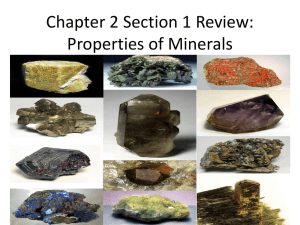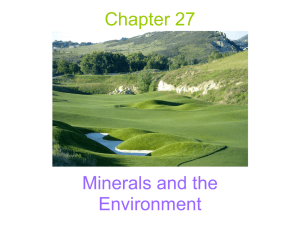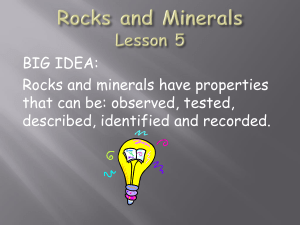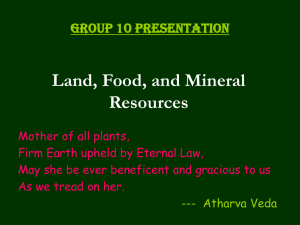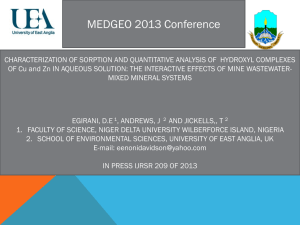A Case Study on Mineral Development in the
advertisement
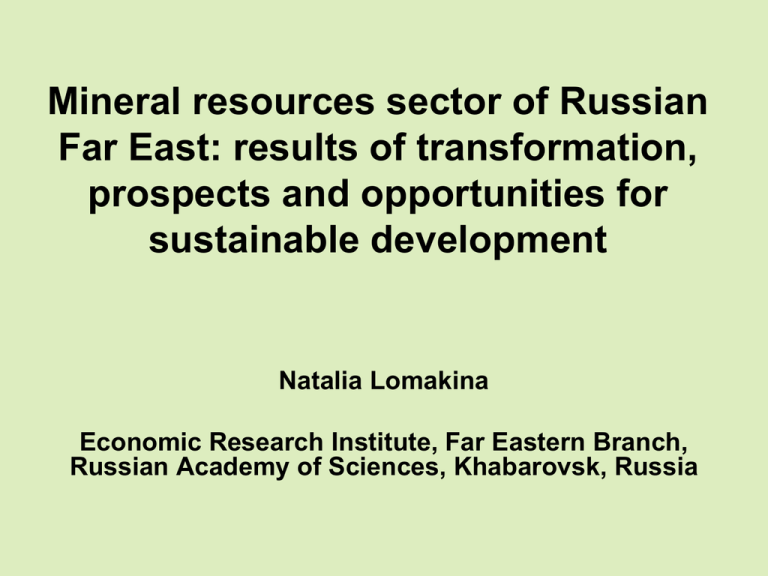
Mineral resources sector of Russian Far East: results of transformation, prospects and opportunities for sustainable development Natalia Lomakina Economic Research Institute, Far Eastern Branch, Russian Academy of Sciences, Khabarovsk, Russia Far East in the Russian economy • Unique economic and geographic location: a “window” from Russia to the dynamically growing Asia-Pacific region; • Territory (6.2 mln square km) – 36.4% of Russia; • Population – 6.5 mln people (4.58% of Russia); • ~5% of Russian GDP; • 9 subjects: Republic of Sakha (Yakutia), Primorsky region, Khabarovsky region, Kamchatka region, Amur region, Magadan region, Sakhalin region, Chukotsky automonous district, Jewish autonomous region. Contents 1. Far East MRS: current situation and trends (2005-2010) 2. Conditions and prospects for development of Far East MRS (2010-2030) 3. Far East mineral resources sector and the international cooperation. 3 Share of Far East mineral resources in the national economy (estimates of 2005, %) Share in Mineral Resources Sector of Russia Extraction Known reserves Probable reserves Diamonds 99.9 80.6 50.0 Gold 40.0 32.9 45.0 Silver 60.0 32.9 85.0 Tin Tungsten 100.0 67.6 95.2 23.9 100.0 60.0 Lead 60.4 8.3 27.4 Zinc 15.4 3.6 15.9 4 Share of Far East mineral resources in the national economy (estimates of 2009, %) Share in Mineral Resources Sector of Russia Extraction Known reserves Probable reserves Diamonds 100,0 81,0 50,0 Gold 50,0 33,0 45,0 Silver 50,0 30,0 85,0 Tin 100,0 92,0 100,0 Tungsten 87,0 23,0 60,0 Lead 63,0 9,0 27,4 Zinc 10,0 3,6 15,9 5 1. Far East mineral resources sector: current situation and trends (2005-2010) 6 Changes in the Far East Mineral Resources Sector. Extraction of New Kinds of Mineral Resources. • Titan-magnetite ores in Amur Region (deposits: Kuranakhsky, Bolshoi Seiim); • Nickel and kobalt in Kamchatsky Region(experimentalindustrial extraction from the Shanuch deposit of kobaltcopper-nickel ores); • Iron ores in Jewish Autonomous Region(Kimkansky and Sutarsky deposits) and Amur Region (Garinsky deposit). 7 Diamond Extraction in the Russian Federation (Ministry of Finance data) Year Weight, thousand carats Cost, million dollars Average cost, dollar/carat 2005 38000 2531 66,61 2006 38361 2575 67,11 2007 38291 2625 68,56 2008 36925 2509 67,95 2009 34759 2340 67,34 8 Changes in the Far East Mineral Resources Sector. Transition to the Underground Diamond Mining Method of extraction 2005 2009 (fact) 2015 2025 Open, % 98 80 35 25 13 65 75 Underground, % 2 9 Gold Extraction in the Main FEFO Gold-Extracting Regions, tons 1991 2000 2005 2006 2007 2008 2009 2009/2008 Russia 133,7 142,7 152,0 147,6 % 144,9 163,9 178,3 108,7 FEFD, 96,2 73,5 79,3 73,6 70,2 89,3 102,4 114,6 Yakutia 32,8 16,1 18,8 19,9 18,9 18,9 18,6 98,4 Khabarovsky region Kamchatsky region Amur region 7,8 9,2 18,2 15,7 14,8 16,2 14,7 90,7 - - 0,2 1,4 2,1 1,5 2,3 153,3 10,8 11,8 14,7 14,5 14,7 18,7 21,9 117,1 Magadan region 30,4 30,0 22,7 17,3 15,3 13,9 13,7 98,5 Chukotsky АD 14,4 6,4 4,7 4,8 4,4 20,1 31,2 155,2 including: 10 Changes in the Far East Mineral Resources Sector. Transition to the Gold Ore Processing (hard rock mining) Share of Gold Extraction from National Deposits, % 2001 2005 2006 2007 2008 Russia 43,5 54,5 57,9 59,5 67,0 Republic of Sakha (Yakutia) 26,0 47,0 49,7 48,5 51,4 Chukotsky АD 17,0 42,9 49,3 56,6 94,2 Khabarovsky region 57,7 69,8 66,0 70,0 72,2 Amur region 23,7 38,9 44,0 49,5 62,0 Magadan region 51,6 46,7 40,0 32,5 29,2 11 The Eastern Regions’ Share in Russia’s Gold Extraction 2001 t 2005 % 2008 t % t 2009 % t % Russia 141,5 100 152,1 100 163,9 100 178,3 100 Siberian Federal District (4 subjects) 48,0 33,9 57,4 37,7 59,9 36,5 60,8 Far Eastern Federal District (6 subjects) 80,0 56,5 79,4 52,2 89,3 54,4 102,4 57,4 Total in Eastern Regions 128,0 90,4 136,8 89,9 149,2 91,0 163,2 91,5 34,0 12 Share of the Far Eastern Enterprises in the Precious Metals Extraction by Large Companies, % Companies 2005 2006 2007 2008 2009 «Polus Zoloto» 3,2 12,0 11,5 11,6 11,0 OJSC «MNPO Polimetal» 68,2 59,3 79,3 72,9 64,8 Kinross Gold Corp - - - 100 100 Petropavlovsk Plc 100 100 100 100 100 Highland Gold Mining Ltd 88,9 73,5 100 100 100 13 Share of Foreign Companies in the Precious Metals Extraction in Russia and the Far East, % Region 2005 2006 2007 2008 2009 Russia 16,8 15,7 15,6 23,0 27,4 Far East, 21,1 21,0 24,0 38,2 46,5 Chukotsky AD … … … 76,6 82,0 Kamchatsky region … 85,7 90,4 93,3 91,3 Khabarovsky region 27,4 31,8 31,0 31,4 34,6 Amur region 47,6 51,0 57,1 65,2 67,5 including: 14 2. Conditions and prospects for development of Far East mineral resources sector (2010-2030) 15 State Programs of Russia’s Eastern Regions Development • Goal: realization of Russia’s national geostrategic interests in the Asia-Pacific region through development of its eastern regions • National Programs: The Strategy of Social and Economic Development of the Far East and Baikal Area for the Period until 2025; The Federal Target Program «Social and Economic Development of the Far East and Trans-Baikal Area for the Period until 2013» • Regional Programs: Strategies and Programs of regional development in the Far East Federal District and Trans-Baikal Area 16 Prospective role of the Far East mineral sector as defined in state documents • • • The State Strategy of the Far East Development until 2025: «use of natural resources potential is a real competitive region’s position in the domestic and foreign markets»; a structural task– modernization and holding the leading role of mining industry as a specialization core in the Far East economy The Federal Target Program for Development of the Far Eastern Regions until 2013: «positioning of the Russian Far East economy … is to be implemented on the basis of natural resources extraction and processing development and the region’s transit capacity» 17 The Driving Factors of the Far East’s Mineral-Resources Sector Development 1. The major international and national corporations define strategies, quantitative and qualitative characteristics of the mineral sector future development 2. The Far East mineral sector further development cannot be achieved without considerable technological transformations 18 Examples of Innovation Approaches in the Far East Mineral Sector Development «Appraisal - Exploration» stage • «Polus Zoloto» (Natalka,Yakutia deposits); • «Polimetall» (Albazino, Maiskoe); • «Kinross» ( Kupol); • «Petropavlovsk» (Pioneer and Malomyr) 19 Examples of Innovation Approaches to the Far Easts Mineral Sector Development «Development & Mining/ Processing» Stage • «Polimetall»: inter-regional project «Albazino Amursk», «Maiskoe - Amursk» (pressure oxidation technology) • «Petropavlovsk»: inter-regional project «Far Eastern metal works» (direct reduced iron production - ITmk3 technology) 20 Level of exploitation in the Far East Mineral Sector (as of 2009/01/01) Products Mineral reserves transferred for use (licenses issued for exploitation), % Diamonds Gold 83.2 86.5 Silver Platinum Tungsten Lead 85.3 100 31 44.9 Zinc Tin Iron 84.4 31.3 16.9 Manganese 72 21 Return of Government to the Mineral Sector: Institutional and Financial Aspects 1) State participation in reproduction of mineral resources under the market economy (the Long-term State Program of Mineral Resource Reproduction until 2020) 2) Attempt of long-term planning of interrelated development of mineral sectors and territories (strategic creation of local centers of economic development (CEDs) instead of commonpurpose financing and random licensing of mineral resource objects) 22 Federal Financing of Exploration Works • • • • 2008 – 22 billion rubles 2009 – 18.9 billion rubles 2010 – 18 billion rubles 2011-2012 – 14 billion rubles • Annual financing benchmark for the implementation of the Long-term State Program of Mineral Resource Reproduction until 2020 - 35-40 billion rubles 23 Fundamental Characteristics of the Economic Development Centers • availability of diverse mineral resource potential and capability to increase it substantially; • necessity and feasibility of infrastructural transformations in the region by implementation of state development programs; • financing the Economic Development Centers by means of public-private partnership mechanism; • capability to use the above mentioned factors to ensure sustainable economic growth and development of territories. 24 The Far East Economic Development Centers ready for real investment Economic Development Centers Key types of resources Start of works Labor, thousands of people YanoKolymskiy Gold 2012 60,0 YuzhnoYakutskiy Coal, Iron, Gold, Uranium 2010-2015 30,0 Yuzhno Kamchatskiy Gold, Silver, Nickel 2010 7,0 Kupolniy Gold, Silver 2008 2,5 Stanovoy Iron, Titanium, Gold 2010-2015 4,0 Khinganskiy Iron, Manganese, Gold 2015 7,0 25 Prospective Centers of Economic Development of national level CED, region YanoKolimsky (Magadan region, Yakutia) SouthYakutia (Yakutia) Key mineral Start of Yearly resources exploitation output capacity Gold, ton 2012 100 Number of new jobs (thousand) 60 Coal, mln. ton 30 2010-2015 32-37 Iron, mln. ton 20 Gold, ton 10 Uran, thousand ton 5 26 Example: Correction of exploitation schedule for Natalka deposit Schedule before the economic crisis After-crisis corrections •2010 – start of exploitation •2013 – reach production of 40 ton of gold for the next 30-40 years •2020-2030 гг. – reach maximum output of 125 mln ton as a whole Yano-Kolimsky gold mining area, by gradual addition of other deposits (Pavlik, Degdekan, Badran etc.) •2013 - launch of gold extraction facility, capacity of 10 mln ton of ore per year; •2017 – increase output to 20 mln ton of ore per year; •2022 г. – reach maximum output of 40 ton of gold per year 27 3. Far East mineral resources sector and the international cooperation. 28 International cooperation of Far East mineral resources sector. 1. Trade Cooperation 1. Export product structure • • precious metals and stones – more then 95% ores and concentrates – about 5% 2. Export geographical structure precious metals and stones: • • • • European countries – more then 70%, Middle East countries - more then15%, North American countries – about 4%, NEA countries – less then 1% ores and concentrates: • • • NEA countries – more then 75% (China – about 45%, Japan – about 20%, Korean Republic - more then 10%) European countries – more then 20% ASEAN – less then 1% 29 International cooperation of Far East mineral resources sector. 2. Investment Cooperation • According to The Far East Development Strategy until 2025 investments needs for new mining and processing clusters in FEFO (including resource and infrastructure projects) exceed $30 billion. • Ex. 1: In 2007 the rate of the Republic of Korea’s investments to Russian mineral resource industry started to grow. In 2008 Korean investments in this sector were on the 2nd place in the whole structure (24.4%). The potential investment area is metal industry ( Khalaktyrskoe titanium-magnetite sand deposit at Kamchatka). • Ex. 2: Chinese companies activity: The formation of the mining and metallurgical cluster in Amur Area on the first step will be financed by Xuan Yuan Industrial Development (XY Group, China), that will extend credit to Joint Venture “Petropavlovsk” at the rate of about $375 mln for 10 years (70% of all work cost) 30 International cooperation of Far East mineral resources sector. 3. Technological Cooperation • Ex.: Direct Iron Production (DRI), “Petropavlovsk”. • ITmk3 - innovation developed by Kobe Steel Corporation (Japan). It is the third and the last for nowadays technology for obtaining the raw material for steel production. • ITmk3 technology advantage: possibility to reduce cost, production period (10 minutes) and carbonic acid emissions. 31 International cooperation of Far East mineral resources sector. 4. Joint Ventures Foundation. • Ex. 1: Joint development of Eugenjevskoe apatite deposit in Amurskaya Oblast for providing production of 1.2 mln tons of complex phosphatic manure. The apatite concentration plant building in Amur Area and phosphatic manure plant construction in Hegang City (China) • Ex. 2: The plant building for titanium sponge production in Jiamusi City (Joint Venture “Petropavlovsk”& Chinalco). Facility – 15 000 tons p.a. at the beginning and up to 30 000 tons p.a. then. Investments – approx. $30 mln. Joint Venture: 65% “Petropavlovsk” and 35% - Chinalco. Employment – 3 000 people. Raw materials – from Kuranakhskiy ilmenite- titanium- magnetite deposit in Amurskaya Oblast 32 International cooperation of Far East mineral resources sector. 5. «Cooperation program» for 2009-2018 between Far East and East Siberia regions and North-East of China». 1. Projects with “industrial” potential (Examples: industrial exploitaition of Yagodninsky zeolites deposit, production of heat insulation materials from perlite, Nachikin and Paratun deposit in Kamchatka region); 2. Projects with significant “industrial” potential but high risk of implementation of raw product output scenario (Examples: exploitation of Kimkan-Sutar iron ore deposit in Jewish Autonomous region); 3. Projects, planned for implementation of only raw material output scenario (Examples: exploitation of Evgenevsky apatite deposit in Amur region for production of complex phosphate fertilizers in Hegan city area (China); exploitation of Kuranah ilmenittitanmagnetit deposit in Amur region for supply of raw materials to titan sponge plant in Jiamusi city (China). 33 Threats of the raw materials production development scenario of Russian Far East, for national and regional economies • Possible threats for national economy: loss of control over supply of strategic mineral resources to russian industry; weakening position of Far East as Russian farpost in the Asia Pacific region • Possible outcomes for Far East: strengthening of resource-export specialization of the regional economy, dependence of regional economy on commodity markets price dynamics, depletion of resource-based growth potential 34 Some conclusions and key tasks • Far East mineral resources sector will keep its national specialization in near future • Potential for international cooperation of Far East mineral resources sector is quite high • The key question is that of estimating the mineral resources sector contribution to the sustainable regional development. • The high-priority theoretical and practical tasks are: estimation of “full” effects of exploitation of mineral resources for regional development, search of the ways to determine structure (disintegrate private benefits and regional development) and localization (effects inside and outside region/national border) of these effects. 35 Thank you for attention! Prof. Natalia Lomakina Economic Research Institute, FEB, RAS Khabarovsk, Russia lomakina@ecrin.ru

